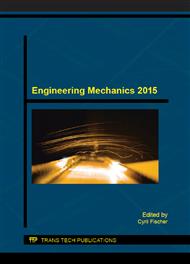[1]
AIJ LSD, Standard for Limit State Design of Steel Structures, Architectural Institute of Japan - AIJ (1990).
Google Scholar
[2]
AISC LRFD, Load and Resistance Factor Design Specification for structural steel buildings, American Institute of Steel Construction - AISC (1994).
Google Scholar
[3]
A. Anastasiadis, M. Mosoarca and V. Gioncu, Prediction of available rotation capacity and ductility of wide-flange beams: Part 2: Applications, Journal of Constructional Steel Research. 68 (2012) 176–191.
DOI: 10.1016/j.jcsr.2011.08.007
Google Scholar
[4]
D. Beg, E. Zupancic and I. Vayas, On the rotation capacity of moment connections, Journal of Constructional Steel Research. 60 (2004) 601–620.
DOI: 10.1016/s0143-974x(03)00132-9
Google Scholar
[5]
CSN EN 1993-1-1 ed. 2 (731401), Eurocode 3: Design of steel structures - Part 1-1: General rules and rules for buildings, Czech Standards Institute (2011).
Google Scholar
[6]
V. Gioncu, D. Petcu, Available rotation capacity of wide-flange beams and beam-columns Part 1. theoretical approaches, Journal of Constructional Steel Research. 43 (1997) 161–217.
DOI: 10.1016/s0143-974x(97)00044-8
Google Scholar
[7]
V. Gioncu, D. Petcu, Available rotation capacity of wide-flange beams and beam-columns Part 2. Experimental and numerical tests, Journal of Constructional Steel Research. 43 (1997) 219–244.
DOI: 10.1016/s0143-974x(97)00045-x
Google Scholar
[8]
P. Janas, I. Kolos and R. Fojtik, Classification of steel mine support sections as per EC3 classification, Advanced Materials Research, Vol. 969, Trans Tech Publications, Switzerland (2014) 63-66, DOI: 10. 4028/www. scientific. net/AMR. 969. 63.
DOI: 10.4028/www.scientific.net/amr.969.63
Google Scholar
[9]
J. Kralik, Deterministic and probabilistic analysis of steel frame bracing system efficiency, Applied Mechanics and Materials, Vol. 390 (2013) 172-177.
DOI: 10.4028/www.scientific.net/amm.390.172
Google Scholar
[10]
M. Krejsa, P. Janas, I. Yilmaz, M. Marschalko and T. Bouchal, The Use of the Direct Optimized Probabilistic Calculation Method in Design of Bolt Reinforcement for Underground and Mining Workings, Scientific World Journal, Vol. 2013 (2013).
DOI: 10.1155/2013/267593
Google Scholar
[11]
A. Markopoulos, P. Janas and J. Podesva, Effective bending stiffness of TH-29 profile, in: Proceedings of the conference New Trends in Statics and Dynamics of Building, Slovak University of Technology in Bratislava, 2010, pp.101-102.
Google Scholar
[12]
L. Randyskova, P. Janas, Nonlinear solution of steel arch reinforcement with influence of passive forces, Transactions of the VŠB – Technical University of Ostrava, Civil Engineering Series, Vol. 11, Issue 1 (2011).
DOI: 10.2478/v10160-011-0012-0
Google Scholar
[13]
M. Shokouhian, Y. Shi, Classification of I-section flexural members based on member ductility, Journal of Constructional Steel Research. 95 (2014) 198-210.
DOI: 10.1016/j.jcsr.2013.12.004
Google Scholar
[14]
T. Wilkinson, G. Hancock, Predicting the rotation capacity of cold-formed RHS beams using finite element analysis, Journal of Constructional Steel Research. 58 (2002) 1455–1471.
DOI: 10.1016/s0143-974x(02)00006-8
Google Scholar


